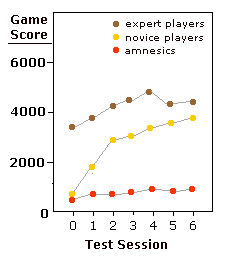October 16, 2000
Tetris Dreams
 Image: after STICKGOLD et al., Science LEARNING CURVE. Experts, novices and amnesiacs playing Tetris show different patterns of improvement over seven sessions--patterns that are in part reflected in their dreams. |
The idea that sleep, and in particular dreaming, serves to cement new information and skills in the brain first gained a lot of attention when Stickgold and his colleagues described another set of findings in the March 1999 issue of the Journal of Cognitive Neuroscience. In this set of experiments, they showed that subjects who had slept for six hours or more after learning a new task--in this case, spotting a visual target on a screen as quickly as possible--improved, whereas those who didn┐t sleep on it didn┐t. Moreover, they found that those who improved the most slept for eight hours, with ample time for both slow-wave and rapid eye movement (REM) periods of sleep.
Stickgold hypothesized why these sequential phases of sleep were so crucial, describing a two-step process by which memories important to learning were consolidated and integrated in the brain. During slow-wave sleep, the hippocampus--a region of the brain that stores recent, episodic memories about discrete events--replays its files for the neocortex, home to more permanent memories. The communication between the two brain areas at this time is one way, from the hippocampus to the neocortex. During the REM dreaming that follows, though, the flow of information flips, from the neocortex back to the hippocampus. Stickgold suggested that once the neocortex connects the new memories to others in storage, it sends a message back to the hippocampus to erase them.
In this latest round of experimentation, Stickgold and his team probed yet a third phase of dreaming--the hypnagogic period that occurs within the first hour of sleep. They studied three different sets of subjects who all played Tetris over the course of three days--playing for two hours in the morning and in the evening on the first day, and for an hour each morning and evening on the following days of the study. Twelve of their subjects had never before played the game. Another 10 were experts who had logged between 50 and 500 hours of Tetris prior to the experiment. And the remaining five were amnesiacs, having no short-term memory due to lesions in the hippocampus.
 Image: after STICKGOLD et al., Science THOUGHTS AND IMAGES. Reports about Tetris differed depending on when they occurred. Thoughts alone were more common among subjects before sleep, and images were more prevalent after sleep. In all, though, the reports were astonishingly similar. |
Seventeen of these 27 subjects reported seeing the same images during hypnagogic sleep--namely falling geometric pieces that, if placed properly, rack up points in Tetris. And, interestingly, most of these reports occurred after the second night of the study. This delay suggests to the researchers that the need to learn may in part prod the brain into dreaming. ┐It┐s as if the brain needs more time or more play before it decides, ┐Okay, this is something that I really need to deal with at sleep onset,┐ Stickgold says.




